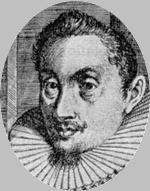

German composer, one of the greatest German masters at the high tide of renaissance music. He was born 1564 in Nürnberg as son of the organist Isaac Hassler, who originally came from Joachimsthal. In Nürnberg Hans Leo grew up during the decade of Lechner's activity in that town and probably was a pupil of the latter. In 1584 he left to receive instruction in Italian music at its source from Andrea Gabrieli in Venice in 1584-5. From 1686 the organist Hassler entered the service of Count Fugger at Augsburg, to whom he dedicated his first collection of Italian canzonettas in 1590. In 1595 Hassler, together with his brothers Jacob and Gaspard was raised to the nobility by the Emperor Rudolph II. In Augsburg he worked for a time at the church of S. Moritz, and (in 1600) being head of the town band. He returned to his native town in 1601, and at the beginning of the following year was appointed kaiserlicher Hofdiener von Haus aus (Imperial servant of the first order), and commissioned to undertake some commercial journeys on behalf of the Emperor, which apparently left him sufficient time to have an eye to his own interests. 1604 he changed his residence to Ulm and there married the daughter of a local merchant (1605). In 1608 he moved to Dresden, where he was appointed court organist by the Elector of Saxony and given charge of the latter's library of music. His remaining years were also marred by illness; he died of consumption on June 8th 1612 at Frankfort- am-Main, whence he had accompanied the Elector for the coronation of the new Emperor.
His rich creative work comprises masses, Latin and German motets, chorales and songs as well as instrumental music in the form of intradas and canzonas on the Venetian pattern as well as pieces for the organ. In his church music he was influenced by Lassus, whereas his Italian secular music shows his thorough familiarity with the up-to-date style of Vecchi and Marenzio. The specifically Venetian influence is felt most in his double-choir madrigals and Lieder. His best Lieder collection is the 1601 Lustgarten, with its dance songs and instrumental intradas for consort. His Lieder show some advancement on Lechner's. Whilst the latter used a style which seems austere and restrained by comparison, and shows strong traces of the strict contrapuntal treatment characteristic of the Netherlands tradition, Hassler definitely prefers the easy-swaying dance-song and often chooses Italian madrigals which he had himself translated into German for his lyrical texts. His Ich brinn und bin entzündt gen dir is a German version, accurately conforming in contents and form, of a famous madrigal by Battista Guarini Ardo si, ma non t'amo, which has repeatedly been set to music. Stylistically he bases his music on the foreign model to an even greater extent than Lechner did, but imbues his choral works with an equal amount of sincere and warm feeling, as is shown sufficiently by his madrigal Mein Gemüt ist mir verwirret, the melody of which, in conjunction with a new text by Paul Gerhardt--O Haupt voll Blut und Wunden-- has become one of the most stirring German chorales.